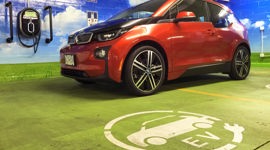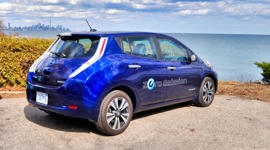FARMINGTON HILLS, Michigan – Automakers have promised us self-driving cars, but they’re far from an overnight sensation. Their complex systems will include various technologies that have been on the market for years, stitched together to create something bigger than the sum of its parts.
Nissan now has a “building block”: its new ProPilot Assist, which will debut on the all-new 2018 Leaf. It stresses it’s only a driver assist system, not a hands-free feature. It’s similar to systems offered by some other manufacturers, including Acura and Mercedes-Benz, but the company says the difference is in putting it on a lower-priced vehicle. It’s already available in Japan, where 60 percent of buyers opt for it, and Nissan intends to eventually offer it here on several models.

The new Leaf won’t be unveiled until September, and so I drove a Rogue equipped as a prototype.
Highway system now, city-capable in four years, Nissan estimates
The system currently concerns itself only with its own lane and primarily on the highway, but within two years, it’s expected that a beefier version will integrate navigation and blind spot monitoring, allowing the vehicle to change lanes. In four years, it should be ready for prime time in the city, paying attention to turns and red lights. All of this is already in Nissan’s tool box – as with most automakers, the company works about five years ahead – but says it’s rolling it out gradually to keep it at a mainstream price.
The system uses two existing technologies, a radar system in the front grille and a camera inside the windshield, which currently operate intelligent cruise control and lane-departure warning systems. ProPilot Assist also taps into the electric power steering, throttle control, and electronic parking brake.

When operational, the system maintains its position behind the car in front – you can set how large of a gap you prefer – and makes steering corrections to keep the vehicle in the centre of the lane. Nissan’s current lane-departure assist applies selective braking to nudge the car back into its lane if you cross the line, but this is more sophisticated. The assist system would simply bounce you back and forth between the markers, while this one stays in the middle.
The system can also tackle stop-and-go traffic, coming to a complete stop if the vehicle ahead does. If that car moves within three seconds, the ProPilot-equipped vehicle will start up again and follow it. If it’s longer, you have to tap the throttle or hit the cruise control’s resume button to get everything going again. The intelligent cruise control can be used on its own if desired, without the lane-keeping.
All manufacturers’ assist systems could drive for hours on their own on a straight-through road, but laws currently restrict how long you can keep your hands off the wheel. If the ProPilot system doesn’t detect driver input over a specific period, it’ll flash a warning signal. Even holding the wheel too loosely, without providing some resistance, is enough to trigger it. It’ll ramp up the warnings if you ignore it, eventually adding brake pulses and, in a last-ditch effort, slowing down and turning on the four-ways, and finally bringing the vehicle to a stop.
Set it like current cruise control, sit back like in luxury cars

It’s a simple, two-button system on the steering wheel: turn on ProPilot and then set the cruise control to the desired speed. Graphics in the centre cluster turn green when all systems are working; grey if they’re turned off; yellow if there’s an issue such as unreadable lane markings; and red for warnings, including lack of wheel input. That simplicity is paramount, according to Larry Smythe, Nissan’s principal engineer of human engineering and head of the team that designed the interface. He was also my navigator during a 50-minute drive along a freeway that included everything from sailing at 112 km/h to stop-and-go stretches of Michigan’s infamous highway construction.
“People have a conversation with any control,” Smythe says. “It’s question and answer, and the challenge is whether it’s easy to understand. When it turns from green to yellow, it’s telling you a story. It tells you its operational state, and there’s no guessing because it’s very clear. It’s in connecting new technology with existing technology, so that it’s easy to learn. If I do my job correctly, the HMI (human-machine interface) becomes a trusted friend.”
He certainly had a skeptic on his hands. I like being in control of my car. I’m not that keen on adaptive cruise control – I hate how it dogs in behind a slightly slower car in front, whereas with regular cruise control, I start my passing manoeuvre ahead of time – and lane-keeping systems can make the wheel feel squirmy.
But Smythe figured that even if I didn’t jump out of the car yelling hallelujah, he believed he’d done his job well enough that I’d at least become comfortable with it. And this wasn’t a case of Young Techno-in-Utero trying to assimilate Old Analogue Gal into the collective. Smythe’s old enough that he’ll be long retired when cars finally take you to your destination all on their own. He knows how to make technology attractive to people because, in addition to being an engineer, he has a degree in psychology.
Even this skeptic became comfortable with it, eventually

I’ve driven several of these types of systems before, and I don’t think I’ll ever get over my habit of hitting the brakes when I’m coming up on another car at higher speed, even when I know my vehicle is going to apply them any second now… nope, can’t do it. I still hovered over the pedal at first when my Rogue approached at low speed, but I took a deep breath and let it do its job. (I got hit head-on many years ago and Smythe suspects that probably accounts for much of my unease, since most of my colleagues have no issues when driving with such systems.)
But here’s the thing: just as he predicted, I got comfortable with it. Nobody who offers this type of technology puts out a bad one, and Nissan’s is top-notch. It brakes and accelerates smoothly, especially at lower speeds or with a longer cruise-control gap, and it stays centered with minimal drift, which reduces the squirmy feel. I also like that it reads the lines on both sides. I recently drove a car with a system that only looks at the right-side marker, with the result that it tried to exit the highway when that line led over into the off-ramp.
Like all of them, ProPilot has its limitations. It can handle curves, but not turns. It can’t detect lane markings that are worn or snow-covered – as the company says, if you can’t see the line, the car can’t either. It’s solely dependent on driver input and traffic ahead, unable to react to traffic lights or speed-limit changes.
But it’s an essential building block for systems to come, and in the meantime, it’s an assist system that Nissan says helps to reduce driver fatigue, improves safety, and makes bumper-to-bumper traffic a little more tolerable. And that’s even for hopeless skeptics like me.















